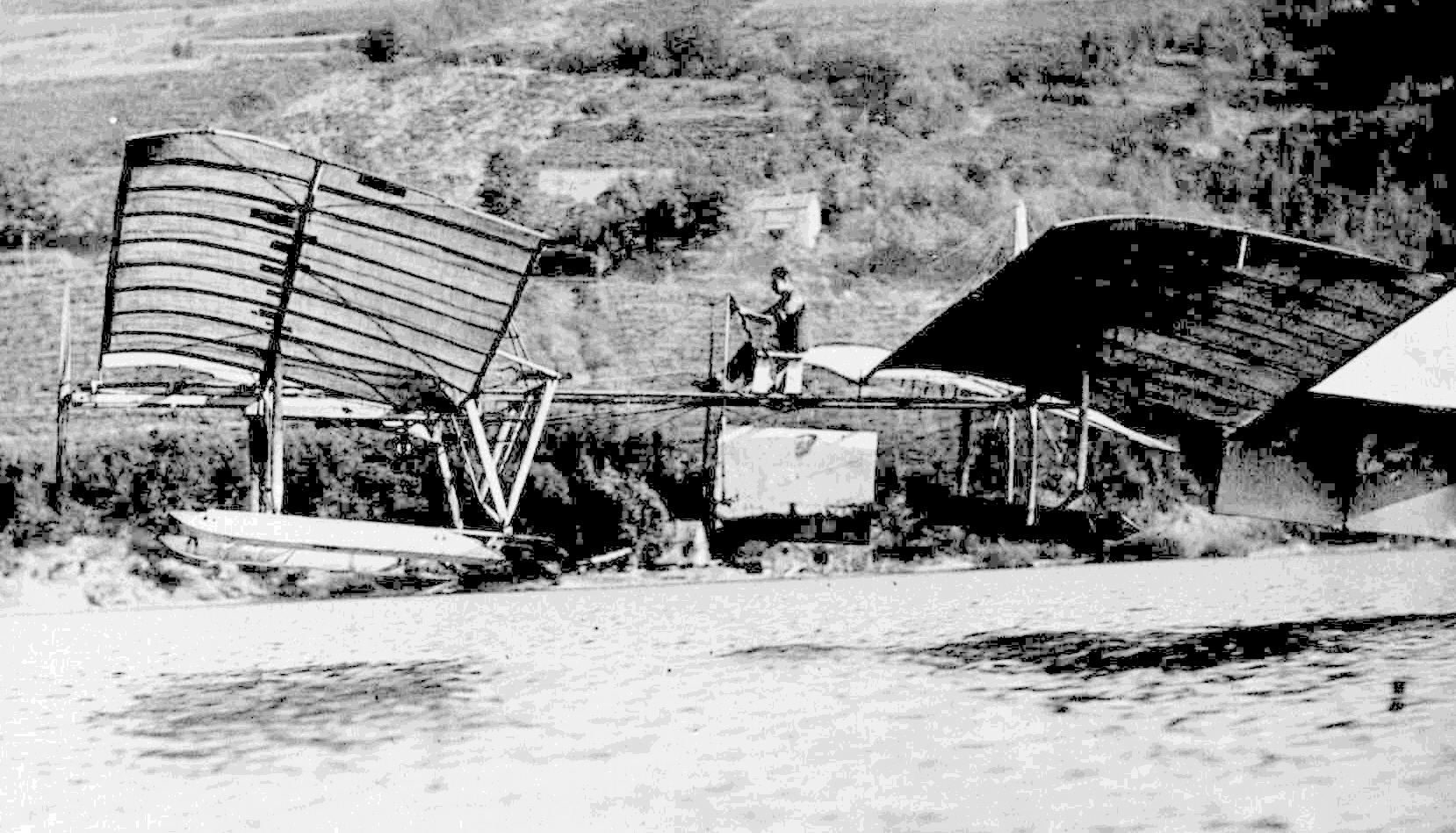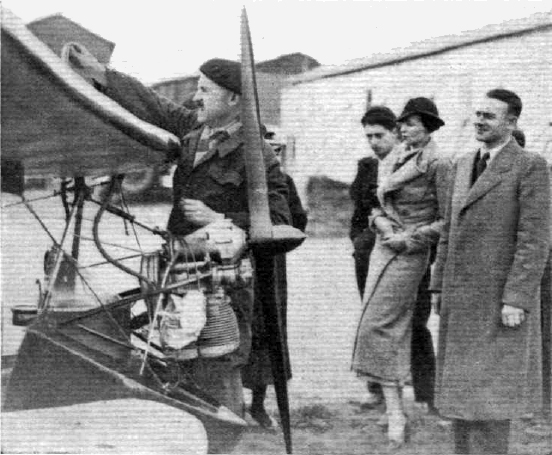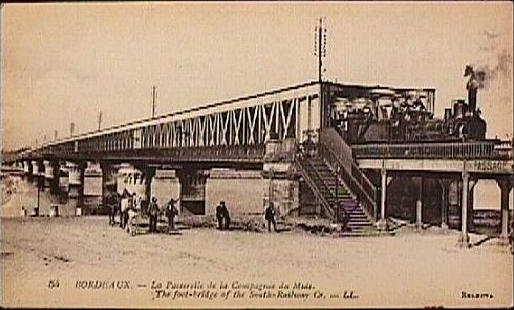|
Tandem Wing
QAC Quickie Q2 A tandem wing is a wing configuration in which a flying craft or animal has two or more sets of wings set one behind another. All the wings contribute to lift. The tandem wing is distinct from the biplane in which the wings are stacked one above another, or from the canard or "tail-first" configuration where the forward surface is much smaller and does not contribute significantly to the overall lift. In aviation, tandem wings have long been experimented with, but few designs have ever been put into production. Tandem wings in nature occur only in insects and flying fish, although in the past there have been tandem-wing flying dinosaurs. Design principles A tandem wing configuration has two main wing planes, with one located forward and the other to the rear. The difference is greater than the wing chord, so there is a clear gap between them and the aircraft centre of gravity (CG) lies between the wings.Bottomley (1977) Compared to the conventional layout, whe ... [...More Info...] [...Related Items...] OR: [Wikipedia] [Google] [Baidu] |
Wing Configuration
The wing configuration of a fixed-wing aircraft (including both glider (aircraft), gliders and powered aeroplanes) is its arrangement of lifting and related surfaces. Aircraft designs are often classified by their wing configuration. For example, the Supermarine Spitfire is a conventional low wing cantilever monoplane of straight elliptical planform with moderate aspect ratio and slight dihedral. Many variations have been tried. Sometimes the distinction between them is blurred, for example the wings of many modern combat aircraft may be described either as cropped compound deltas with (forwards or backwards) swept trailing edge, or as sharply tapered swept wings with large leading edge root extensions (or LERX). Some are therefore duplicated here under more than one heading. This is particularly so for variable geometry and combined (closed) wing types. Most of the configurations described here have flown (if only very briefly) on full-size aircraft. A few theoretical designs ... [...More Info...] [...Related Items...] OR: [Wikipedia] [Google] [Baidu] |
Glenn Curtiss
Glenn Hammond Curtiss (May 21, 1878 – July 23, 1930) was an American aviation and motorcycling pioneer, and a founder of the U.S. aircraft industry. He began his career as a bicycle racer and builder before moving on to motorcycles. As early as 1904, he began to manufacture engines for airships. In 1908, Curtiss joined the Aerial Experiment Association, a pioneering research group, founded by Alexander Graham Bell at Beinn Bhreagh, Nova Scotia, to build flying machines. Curtiss won a race at the world's first international air meet in France and made the first long-distance flight in the U.S. His contributions in designing and building aircraft led to the formation of the Curtiss Aeroplane and Motor Company, which later merged into the Curtiss-Wright Corporation. His company built aircraft for the U.S. Army and Navy, and, during the years leading up to World War I, his experiments with seaplanes led to advances in naval aviation. Curtiss civil and military aircraft were some ... [...More Info...] [...Related Items...] OR: [Wikipedia] [Google] [Baidu] |
Henri Mignet
Henri Mignet, (October 19, 1893 – August 31, 1965), was a French radio engineer who became well known as an aircraft designer and builder.Ellis & Jones (1990)Plane and Pilot: ''1978 Aircraft Directory'', page 142. Werner & Werner Corp, Santa Monica CA, 1977. His most famous design is the ''Flying Flea'' family of aircraft. Early interest in aviation Mignet was born in Charente-Maritime. In 1911, when he was 18 years old, he started corresponding with Gustav Lilienthal (the brother of Otto Lilienthal) about aviation. In 1912, he built his first aircraft, the HM.1-1 model. It was a monoplane inspired by the creations of Otto Lilienthal. Service in the First World War Between 1914 and 1918, Mignet served in the French army. He was a radio operator during World War I. In 1918, he was hospitalized with malaria. Post World War I designs In 1920, Mignet finished his first powered aircraft prototype, the HM.2. This bore many similarities to, and took inspiration from, the design ... [...More Info...] [...Related Items...] OR: [Wikipedia] [Google] [Baidu] |
SFCA Taupin
The SFCA Taupin was a French tandem-wing aircraft, designed to provide a simple, stable and safe aircraft able to take-off and land in small spaces. Design and development In 1907 Louis Peyret, a friend of Louis Blériot designed the tandem wing Bleriot VI. Alex Manerol, flying the Peyret Tandem won the 1922 Itford glider contest and in 1924 Peyret obtained a patent for it. He continued to build designs of this type as well as more conventional aircraft until his death in 1933, after which his patent rights were purchased by the ''Société Française de Construction Aéronautique'' (SFCA). In 1935 they designed and built the tandem wing Taupin which, apart from a different engine, was very similar to the Peyret VI of 1933. Taupin is the French vernacular name for beetles of the family (biology), family Elateridae or click-beetles, known for their ability to jump rapidly into the air. The Taupin had rectangular plan wings, the forward one providing 65% of the wing area, both mo ... [...More Info...] [...Related Items...] OR: [Wikipedia] [Google] [Baidu] |
Société Française De Construction Aéronautique
The ''Société Française de Construction Aéronautique'' (SFCA) was an aircraft manufacturing company based in Buc, France. History The ''Société Française de Construction Aéronautique'' was established on the 24 July 1934 by André Maillet. Most of the aircraft produced by SFCA were light aircraft and trainers. Aircraft * SFCA Lignel 10 * SFCA Lignel 16 * SFCA Lignel 161 * SFCA Lignel 20 * SFCA Lignel 20S * SFCA Lignel 31 * SFCA Lignel 44 * SFCA Lignel 46 Coach * SFCA Maillet 20 * SFCA Maillet 201 * SFCA Maillet 21 * SFCA Maillet-Lignel 20 * SFCA Taupin The SFCA Taupin was a French tandem-wing aircraft, designed to provide a simple, stable and safe aircraft able to take-off and land in small spaces. Design and development In 1907 Louis Peyret, a friend of Louis Blériot designed the tandem wi ... * SFCA Taupin 5/2 References External links Musee Aeronautique Presqu'ile Cote d'Amour {{DEFAULTSORT:Societe Francaise de Construction Aeronautique ... [...More Info...] [...Related Items...] OR: [Wikipedia] [Google] [Baidu] |
Louis Peyret , names sometimes translated to English as "Louis"
{{disambiguation ...
Louis may refer to: * Louis (coin) * Louis (given name), origin and several individuals with this name * Louis (surname) * Louis (singer), Serbian singer * HMS ''Louis'', two ships of the Royal Navy See also Derived or associated terms * Lewis (other) * Louie (other) * Luis (other) * Louise (other) * Louisville (other) * Louis Cruise Lines * Louis dressing, for salad * Louis Quinze, design style Associated names * * Chlodwig, the origin of the name Ludwig, which is translated to English as "Louis" * Ladislav and László - names sometimes erroneously associated with "Louis" * Ludovic, Ludwig, Ludwick, Ludwik Ludwik () is a Polish given name. Notable people with the name include: * Ludwik Czyżewski, Polish WWII general * Ludwik Fleck (1896–1961), Polish medical doctor and biologist * Ludwik Gintel (1899–1973), Polish-Israeli Olympic soccer playe ... [...More Info...] [...Related Items...] OR: [Wikipedia] [Google] [Baidu] |
Peyret Tandem
The Peyret Tandem or Peyret Alérion, was a French single seat glider of tandem wing configuration. It won first prize at the first British Glider Competition of 1922. Design and development Louis Peyret, who had unsuccessfully attempted to fly the Blériot III floatplane and had designed the Blériot VI, a tandem wing aircraft, was a friend of Louis Blériot. His post-World War I glider was a true tandem wing aircraft with two identical pairs of straight edged, constant chord high mounted wings, swept at 5°. Both also had 5° of dihedral but the front wing was mounted at a larger angle of incidence than the rear for longitudinal stability, as is the tailplane in a conventional aircraft. The wings were built up around tubular Duraluminum spars and braced with N shaped lift struts, also Duraluminum but with wooden fairings, which ran from the lower fuselage longerons to mid-span. The fuselage was built around spruce longerons and struts with some plywood frames and cove ... [...More Info...] [...Related Items...] OR: [Wikipedia] [Google] [Baidu] |
Caproni Ca
Caproni, also known as ''Società de Agostini e Caproni'' and ''Società Caproni e Comitti'', was an Italian aircraft manufacturer. Its main base of operations was at Taliedo, near Linate Airport, on the outskirts of Milan. Founded by Giovanni Battista "Gianni" Caproni during 1908, the company produced several successful heavy bombers during the First World War. Following the acquisition of several other aviation firms throughout the interwar period, Caproni transformed into a sizable aviation-orientated syndicate, the ''Società Italiana Caproni, Milano''. The majority of its aircraft were bombers and transport aircraft. It played a pioneering role in the development of the Caproni Campini N.1, an experimental aircraft powered by a thermo-jet. It provided large numbers of combat aircraft for the Axis during the Second World War. The firm did not prosper in the postwar era, the Società Italiana Caproni collapsing during 1950. Many of the company's former assets were subseque ... [...More Info...] [...Related Items...] OR: [Wikipedia] [Google] [Baidu] |
Gustave Eiffel
Alexandre Gustave Eiffel (born Bonickhausen dit Eiffel; ; ; 15 December 1832 – 27 December 1923) was a French civil engineer. A graduate of École Centrale des Arts et Manufactures, he made his name with various bridges for the French railway network, most famously the Garabit Viaduct. He is best known for the world-famous Eiffel Tower, designed by his company and built for the 1889 Universal Exposition in Paris, and his contribution to building the Statue of Liberty in New York. After his retirement from engineering, Eiffel focused on research into meteorology and aerodynamics, making significant contributions in both fields. Early life Alexandre Gustave Eiffel was born in France, in the Côte-d'Or, the first child of Catherine-Mélanie (née Moneuse) and Alexandre Bonickhausen dit Eiffel. He was a descendant of Marguerite Frédérique (née Lideriz) and Jean-René Bönickhausen and who had emigrated from the German town of Marmagen and settled in Paris at the beginning of ... [...More Info...] [...Related Items...] OR: [Wikipedia] [Google] [Baidu] |
Blériot VI
The Blériot VI "Libellule" ("Dragonfly"), was built in 1907 and was one of the series of experimental aircraft built by Louis Blériot which eventually led to the Blériot XI aircraft in which he made the first flight across the English Channel. Design and development Abandoning the canard layout of the Blériot V, Blériot and his chief engineer Louis Peyret next built a tandem wing configuration aircraft, possibly influenced by the Langley ''Aerodrome''. In its initial form the aircraft had two pairs of identical wings rigged with pronounced dihedral mounted on the lower longerons at each end of the wooden box-girder fuselage, with small tip -mounted elevators on the front wings. Triangular fins were mounted above and below the rear fuselage, with a small rudder hinged to their trailing edge. The undercarriage consisted of a pair of wheels on V-struts at the front of the aircraft and a third wheel mounted slightly behind the midpoint of the fuselage. It was powered by a 24& ... [...More Info...] [...Related Items...] OR: [Wikipedia] [Google] [Baidu] |
Blériot III
The Blériot III was an early French aeroplane built by pioneer aviators Louis Blériot and Gabriel Voisin. It was later modified and renamed the Blériot IV, but both versions failed to fly. Design and development The Blériot III was radically different from what was to become the orthodox design for aircraft, having two large elliptical closed wing cells in tandem connected by booms. A single transversely mounted 24 hp (18 kW) Antoinette engine mounted on the lower front wing drove two tractor propellers using flexible drive shafts incorporating reduction gearing to reduce the 1,800 rpm of the engine to 600 rpm. The transmission arrangement accounted for 100 kg of the aircraft's 400 kg weight. The undercarriage consisted of a pair of long floats under the front wing cell and a third below the aft wing cell. Blériot and Voisin attempted to fly it from the Lac d'Engheim in May 1906, but the machine would not become airborne. In October they made major c ... [...More Info...] [...Related Items...] OR: [Wikipedia] [Google] [Baidu] |








